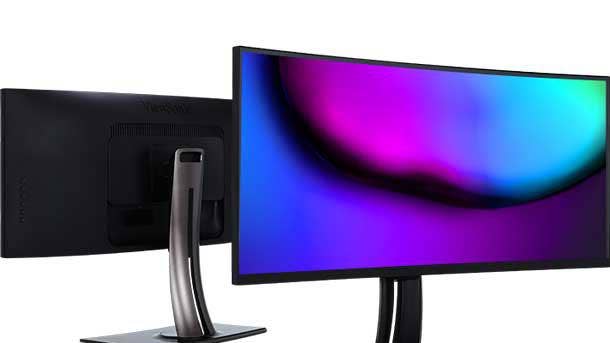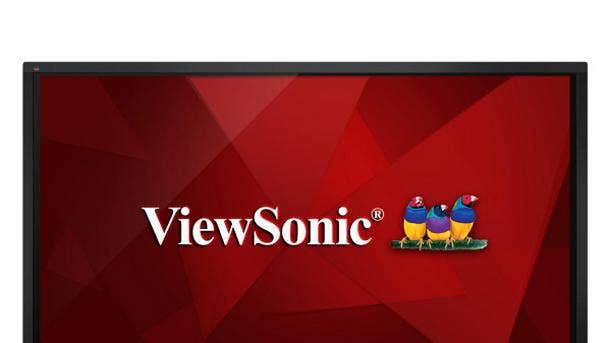ViewSonic’s Jeff Volpe: COVID-19 Crisis Has Boosted Demand For Monitors, Interactive Screens, Collaboration Software
‘I think people are realizing now that the monitor, which is normally an afterthought, is going to become a little bit more popular because of the value that it brings to homes and businesses and collaboration stations and what have you. The densely populated cubicle is probably going to be fading a little bit,’ Volpe, ViewSonic’s president of the Americas, tells CRN.

Navigating The COVID-19 Storm
ViewSonic, one of the IT industry‘s largest branded vendors of monitors and collaboration products, has seen a lot of changes in its business due to the COVID-19 coronavirus pandemic. Demand for its monitors spiked as businesses moved to support their remote workers, while its large education and collaboration markets had to quickly shift to a focus on remote learning and communication, according to Jeff Volpe, president of ViewSonic’s Americas business.
Volpe also told CRN that while ViewSonic depended on manufacturing based near Wuhan, China, which completely shut down at the start of the pandemic, the company got lucky with its supply chain. Late last year, when the U.S. and China were trading words over trade issues, which led to concerns about new tariffs on China-made products, the company placed a huge order for monitors that came in just before the supply chain was impacted by the pandemic.
Here’s how Volpe said ViewSonic is weathering the COVID-19 crisis.

How has COVID-19 impacted ViewSonic's sales?
A big part of COVID-19 for us is just how the demand for our products has escalated. We have seen an increase in demand for monitors and a demand for our interactive screens for schools and our software for collaboration. And in order to keep up with that, we needed a fully functional staff, both in our sales and marketing and our operations.
I‘ve been with ViewSonic 25 years, as many of my peers have been, and a lot of our tenure is pretty high. And I’ll tell you, every time there is some sort of a recession or some sort of an adversity moment, the team just steps up and finds a way to get it done. I couldn’t be more proud of our team and our management team for rallying the troops and keeping everybody focused on our goals and servicing our customers. It’s really been a testament to the quality of the people within this organization.
You said that sales were up. Have you actually had to bring on new people to take care of the increased sales?
No. We‘ve been in business for 35 years, but the last four years we’ve been launching new technologies and we’ve had some shifts in the technology that we’ve been selling. And coincidentally, a lot of those product moves we’ve made have been very appropriate for these times. We started investing in staff three years ago to manage these new solutions as well as handle the increase in demand and customer touch that we had to deal with. Customer touch has to do with sales force and customer service tech support, and some digital marketing stuff to manage this. So we actually front-loaded a great deal of our fixed asset and people acquisitions, and we just pretty much got to the end of that acquisition in December. We’ve had a few people that we hired, but for the most part what we’re seeing now is the fruition of our forecast coming together. And now we’re starting to get that ROI on the resources that we invested in. We more than doubled our company and the number of people we have in the last three years within the North American region, and it’s been very timely for us because of the demand increase. So it’s pleasing that I don’t have to increase my fixed assets at this time.

Which of ViewSonic's product lines have become part of your company's own work-from-home initiative?
It‘s always nice to eat your own dog food. As everybody went home, they all got a nice new monitor. And they had the opportunity to leverage some of our technology that we’ve created.
We have always been a product and a device company, mainly on the backs of our monitors and projection products. Certainly, right now as people have been forced to go into the remote state, our customers and our own company have seen an influx in monitor demand. And the monitor demand for ViewSonic is very good. We‘ve got such a wide breadth of products so we can slice and dice the monitors for our customers based on what their office requirements are. In some cases, we have professional people who need to create content and so they need Adobe Color, large screens and 4K resolution. And so we have a whole host of very high-end products that allow the home remote user to stay very productive. ...
We have a number of our products that obviously are large in size and scope, so [users] can leverage that. And we have what‘s called ViewSplit in many of our monitors, which allows them to split-screen almost like they have dual monitors. So not everybody has to have a dual monitor. Instead, they just get an ultrawide from us, and they use ViewSplit as one of those features to help them be productive in their homes.

What other products?
Our collaboration products are broken into software and hardware. The software side is software that we created and have been evolving over the last four years called myViewBoard, and we have different versions of it for Windows and Android. We have a lot of different features and some other products that can get bolted onto that. It‘s a very agnostic software package where you can import a lot of different technologies and leverage it along with a lot of other platforms on the market, and it allows companies to collaborate and facilitate distance learning, facilitate remote office work and collaboration work, all while leveraging all the popular tools like Microsoft Teams and Zoom, etc. [mViewBoard] is most adopted by our education vertical right now. ...
On the hardware side of our ViewBoard products, we have many different iterations of touch-enabled displays. And some of those small touch-enabled displays have been going into teachers’ homes where they can leverage those as tools for them to work touch features on screen as well as the collaboration tools that we build into our myViewBoard software, which teachers are able to leverage in the home. So that‘s a real fast synopsis on the collaboration products that we offer in myViewBoard.
If you look at the impact of COVID-19, which ViewSonic product line do you think actually grew fastest because of the pandemic over last year?
The monitors have seen growth, our entertainment projectors are seeing some growth, our interactive software is seeing growth. And there‘s a reason for that. As education and government are planning for the return of schools to normal and trying to offer the best education possible, we’re seeing a lot of deployment of new learning tools into schools right now. While they’re closed, the IT groups can go into a lot of the districts and schools in those districts and retrofit their classrooms leveraging the technology that we have in our big-screen products as well as our monitor products. We see this whole vertical as continued growth.
For monitors, it goes without saying that people going to the remote home should find out that the laptop is uncomfortable and not as productive, and they need to get monitors. So enterprises are buying them from us in bulk. Consumers buy them from the channel and they buy them from our e-tail channel as well. So those are the two main growth areas. ... Our nontouch large-screen business has seen a little bit of fragmentation. We have some ups and downs in the aggregate number of units we‘re selling. But I think as businesses return, they’re going to start to see the need for this for collaboration.

Do you expect this growth to continue post-COVID, or might the market step back because it was temporarily flooded?
For ViewSonic, I see growth continuing. And I think one reason is we have retained a lot of investment in presence in the market. We‘ve also maintained some focus on rearchitecting a lot of our programs for our channel partners. And we also see that there is a thirst for quality products that are innovative and leading edge. And our monitor development teams have been producing incredible products that I would say have been underserved from a share perspective in the market. So I see share growth for ViewSonic as well as organic growth. I don’t think that there is going to be an over-saturation of monitors. I think people are realizing now that the monitor, which is normally an afterthought, is going to become a little bit more popular because of the value that it brings to homes and businesses and collaboration stations and what have you. The densely populated cubicle is probably going to be fading a little bit.
We may see some softness in the overall demand in the marketplace as we get into the latter part of the year, maybe early next year, but I think ViewSonic‘s programs and products have a great opportunity to grab market share right now.
Was ViewSonic's supply chain impacted by COVID-19?
I‘m not afraid to admit that luck is sometimes a great asset that a company can have. Actually, as President Trump and China were battling and butting heads regarding tariffs, we opted to bring in some safety stock in November. And that was significant. And that stock mitigated a significant amount of the disruption that we saw in the supply chain in the latter part of February and early part of March.
We were able to get through that really dry period when Wuhan was shut down and not see a significant dip in our sales because we had that excess inventory. For me as a leader, it was nerve-wracking to bring in that extra stock because of cash. But it was delightful to see the demand come and move out that excess inventory, turn that back into cash, but also, importantly, facilitate a lot of businesses with the products that they needed to keep continuity for them going. So not only was ViewSonic lucky, but our customers who wanted products for their remote office and their organizations had a chance to get that product and get their employees home with the right tools to be successful.

How has the pandemic changed how ViewSonic works with its channel partners?
One of those things is to make sure we have our inventory in a position for them to grab and facilitate ongoing projects. A lot of our channel partners haven‘t seen some of the new products that we have had out because they’re so inundated with so many vendors and so many opportunities that not everything gets through to everyone. So we decided to really look at creating better resources that are digital. We’ve been producing more video, more webinars, more sell sheets, more links for our channel partners to get quick information or detailed information. ’Detailed’ means white papers, which are less common these days than they used to be. But nonetheless, we’ve spent a lot of time trying to make our digital resources as apparent as possible. On our website, we’ve made some changes and put out some solutions there that our channel partners can gravitate to and fulfill a lot of an increased demand. That’s one of the obvious things that we and any vendor has to do as a channel company.
Anything else?
We have continued to make sure we put on spifs and rebates to help augment the need for back-end product incentives and situations like that where the resellers, in trying to make payroll, are trying to be competitive. They need access to those spifs and rebates. So we‘ve kept those going and enhanced some of those as well. We also, for our Finch Club members, which is our channel program, we offer bid registration and special pricing. We’re trying to be closer to our channel partners to get them access to bid registration if they’re working on a deal where they’re building ViewSonic solutions into that deal. ...
We will probably see more tweaks to the discussion than I‘ve given to you as we start to see what demands our channel talks with us about because we’re learning things every day: What kind of headache they’re having, what kind of challenges they’re having, what kind of products are in demand that are hard to find, and how do we help them through those challenges.